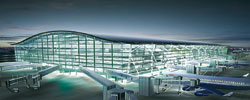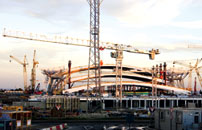 A lengthy permitting process for a fifth terminal at Londons Heathrow airport added years to the projects gestation. While straining the developers patience, the hiatus allowed time to rehearse a novel procurement strategy for the $7.7-billion project that seems to be paying off.
A lengthy permitting process for a fifth terminal at Londons Heathrow airport added years to the projects gestation. While straining the developers patience, the hiatus allowed time to rehearse a novel procurement strategy for the $7.7-billion project that seems to be paying off.
As the main buildings landmark roof is lifted in 2,500-tonne sections, work to boost Heathrow airports capacity by 30 million passengers a year is on time and budget, says Andrew Wolstenholme, project manager with owner BAA plc. "Weve spent $3.5 billion so far and we have delivered a huge piece of infrastructure. We are extremely pleased to be where we are," he says.
 |
| Toward the Future. Fifth terminal will help handle another 30 million passengers. (Photo above and below courtesy of BAA) |
With construction nearly half done, BAA attributes good progress to years of team building with scores of companies working on development. Integrating designers with contractors and relieving them all of normal construction risk "is undoubtedly the right way to do [this project] for BAA," says Wolstenholme.
BAAs investment includes infrastructure, such as 13.5 kilometers of large diameter tunnel and transportation links. But it is the glass-walled main building that will provide the "great passenger experience" that the firms design and development director, Mike Forster, seeks.
| RELATED LINKS |
| Beijings National Grand TheatreTransforms the Cityscape |
| Configuration Led to Spirit Plus Acoustical Richness |
Nearly 400 meters long and 156 m wide, the building rises some 40 m. With no internal supports, the roof and walls enclose six main floors being built on a big structural grid to maximize flexibility for future use. A few hundred paces to one side, a longer, narrower satellite is emerging with features echoing the main buildings. They are due to open in March 2008. Further away is the site of a second satellite, to follow by three years.
Richard Rogers Partnership, London, began design of Terminal Five (T5) in the late 1980s. Efforts by BAA to justify the project were extended by the planning inquiry lasting nearly four years, to 1999. More time passed before the government gave its approval in late 2001.
"The project went back and forth for a few years between 1992 and 1999....It was virtually shut down from our side," says Dennis Austin, the roofs lead architect. But as the green light loomed, BAA pulled together its design team. "Everybody sat in one room in a building just off the northern runway and we lived together for about three years," he says.
 |
| Lifting Stages. System for erecting trusses was defined by 43-m ceiling imposed by air traffic control that limited use of tower cranes. |
By combining engineers, architects and contractors in design teams, BAA strove to sidestep the U.K. construction industrys traditional blame culture, says Wolstenholme. BAAs uniting with contractors to complete the Heathrow Express railroad project to London after one of its tunnels collapsed a decade ago was "the trigger point to work with integrated teams," says Wolstenholme.
In the mid-1990s, BAA began establishing framework agreements with contractors. Hired for classes of work rather than fixed contracts, the companies operate in teams with BAA and other players. With guaranteed profits, the companies work on an open-book basis, says commercial director Matthew Riley.
Improved transparency and the ability to reuse experience learned are among the targeted advantages of the frameworks, says Riley. The first agreements were dress rehearsals for T5, he says. Scores of such deals now operate on the new terminal project.
Rowen Structures Ltd., Nottingham, for example, has an agreement that includes supplying and erecting steelwork for the T5 development. The terminal roof alone contains over 18,000 tonnes of steel. Rowen values its T5 work at about $315 million.
Because of its size, the development is divided into nearly 20 packages. Common suppliers are active on all fronts, coordinated by BAA. Steel supplier Corus plc, London, for instance, has 35 different interfaces. Left uncoordinated, there would be "all sorts of inefficiencies in that process," says Riley.
|
Working Toward Harmony
Among the most unusual features of BAAs strategy is its attempt to eliminate disputes when things go wrong. Normally, "you get all the best brains focused on managing the effects of risk rather than on mitigating the risk," says Riley.
So BAA has absolved companies working for it on T5 of their normal contractual risks. "You are deluding yourself if you think you can transfer corporate risk through contracts," says Riley. BAA even pays for design and construction insurance in an arrangement that Riley believes is unique in the U.K.
"Its the first time Ive worked in [such a] very close arrangement," says Dervilla Mitchell, a director of Arup Group Ltd., London, who heads the projects design management. She also leads the structural engineering.
Once a conceptual structural design emerged, a "dialogue" began between architects, engineers and contractors, says Mitchell. It resulted in "a number of ideas, which eventually became the current scheme," she adds.
"The team worked very well together and gelled from the early days," says Tony Whitten, contracts director for Watson Steel Ltd., Bolton, a division of T5...

Post a comment to this article
Report Abusive Comment